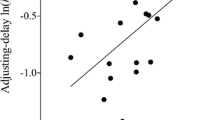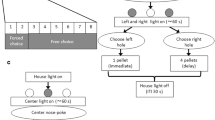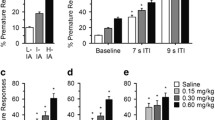Abstract
Background
d-Amphetamine (AMPH) is a widely prescribed attention deficit hyperactivity disorder medication, but little is known about its effects on impulsive choice with escalated use.
Objective
The current study examined the effects of short and long access to AMPH self-administration on impulsive choice in a delay discounting task in which rats chose between a small immediate reward (one sucrose pellet immediately) and a larger delayed reward (three sucrose pellets after an adjusting delay).
Methods
Following choice stability in delay discounting, all rats received 15 1-h sessions of AMPH self-administration (0.1 or 0.03 mg/kg/infusion); self-administration sessions began 45 min after each delay discounting session. Rats were then either maintained on the short access (ShA) self-administration session or were switched to a long access (LgA) 6-h session for 21 days, followed by a 7-day withdrawal phase in which only the delay discounting task continued.
Results
LgA rats in the 0.03 mg/kg/infusion dose group escalated in total number of infusions across sessions, although rats in the 0.1 mg/kg/infusion dose group did not. LgA groups at both unit doses showed decreased mean adjusted delays across sessions compared to the ShA groups, indicating that long access to AMPH increases impulsive choice. During the AMPH withdrawal phase, LgA groups returned back to baseline mean adjusted delays, indicating that the effect on impulsive choice was reversible.
Conclusion
These results show that extended AMPH self-administration produces a transient loss of inhibitory control, which may play a role in the escalating pattern of drug intake that characterizes the addiction process.





Similar content being viewed by others
References
Ahmed SH, Koob GF (1998) Transition from moderate to excessive drug intake: change in hedonic set point. Science 282:298–300
Ahmed SH, Koob GF (1999) Long-lasting increase in the set point for cocaine self-administration after escalation in rats. Psychopharmacology 146:303–312
Ahmed SH, Koob GF (2004) Changes in response to a dopamine receptor antagonist in rats with escalating cocaine intake. Psychopharmacology 172:450–454
Ahmed SH, Koob GF (2005) Transition to drug addiction: a negative reinforcement model based on an allostatic decrease in reward function. Psychopharmacology 180:473–490
Ahmed SH, Walker JR, Koob GF (2000) Persistent increase in the motivation to take heroin in rats with a history of drug escalation. Neuropsychopharmacology 22:413–421
Ahmed SH, Lin D, Koob GF, Parsons LH (2003) Escalation of cocaine self-administration does not depend on altered cocaine-induced nucleus accumbens dopamine levels. J Neurochem 86:102–113
Allen RM, Dykstra LA, Carelli RM (2007) Continuous exposure to the competitive N-methyl-D aspartate receptor antagonist, LY235959, facilitates escalation of cocaine consumption in Sprague–Dawley rats. Psychopharmacology 191:341–351
Berman SM, Kuczenski R, McCracken JT, London ED (2000) Potential adverse effects of amphetamine treatment on brain and behavior: a review. Mol Psychiatry 14:123–142
Bickel WK, Odum AL, Madden GJ (1999) Impulsivity and cigarette smoking: delay discounting in current, never, and ex-smokers. Psychopharmacology 146:447–454
Biederman J, Wilens T, Mick E, Spencer T, Faraone SV (1999) Pharmacotherapy of attention deficit/hyperactivity disorder reduces risk for substance use disorder. Pediatrics 104:e20
Cabeza de Vaca S, Carr KD (1998) Food restriction enhances the central rewarding effect of abused drugs. J Neurosci 18:7502–7510
Carroll ME, Meisch RA (1984) Increased drug-reinforced behavior due to food deprivation. In: Thompson T, Dews PB, Barrett JE (eds) Advances in behavioral pharmacology. Academic, New York, pp 47–88
Coffey SF, Gudleski GD, Saladin ME, Brady KT (2003) Impulsivity and rapid discounting of delayed hypothetical rewards in cocaine-dependent individuals. Exp Clin Psychopharmacology 11:18–25
Dallery J, Locey ML (2005) Effects of acute and chronic nicotine on impulsive choice in rats. Behav Pharmacol 16:15–23
de Wit H (2009) Impulsivity as a determinant and consequence of drug use: a review of underlying processes. Addiction Biol 14:22–31
de Wit H, Enggasser JL, Richards JB (2002) Acute administration of d-Amphetamine decreases impulsivity in healthy volunteers. Neuropsychopharmacology 27:813–825
Dworkin SI, Porrino LJ, Smith JE (1992) Importance of behavioral controls in the analysis of ongoing events. Neurological Approaches to Brain-Behavior Interactions, NIDA Res Monogr 124:173–188
Evans KR, Vaccarino FJ (1987) Effects of d- and 1-amphetamine on food intake: evidence for a dopaminergic substrate. Pharmal Biochem Behav 27:649–652
Evenden JL, Ryan CN (1996) The pharmacology of impulsive behaviour in rats: the effects of drugs on response choice with varying delays of reinforcement. Psychopharmacology 128:161–170
Grasing K, Szeto H (1993) EEG changes with different levels of morphine self-administration. Neuropharmacology 32:543–553
Green L, Myerson J, Holt DD, Slevin JR, Estle SJ (2004) Discounting of delayed food rewards in pigeons and rats: is there a magnitude effect? J Exp Anal Behav 81:39–50
Jacobs EH, Smit AB, de Vries TJ, Schoffelmeer ANM (2003) Neuroadaptive effects of active versus passive drug administration in addiction research. Trends Pharmacol Sci 24:566–573
Kitamura O, Wee S, Specio SE, Koob GF, Pulvirenti L (2006) Escalation of methamphetamine self-administration in rats: a dose-effect function. Psychopharmacology 186:48–53
Koob GF, Kreek MJ (2007) Stress, dysregulation of drug reward pathways, and the transition to drug dependence. Am J Psychiatry 164:1149–1159
Lambert NM, Hartsough CS (1998) Prospective study of tobacco smoking and substance dependencies among samples of ADHD and non-ADHD participants. J Learn Disabil 31:533–544
Logue AW, Peña-Correal TE, Rodriguez ML, Kabela E (1986) Self control in adult humans: variation in positive reinforcer amount and delay. J Exp Anal Behav 46:159–173
Mandyam C, Wee S, Eisch AJ, Richardson HN, Koob GF (2007) Methamphetamine self administration and voluntary exercise have opposing effects on medial prefrontal cortex gliosis. J Neurosci 27:11442–11450
Mandyam C, Wee S, Crawford E, Eisch A, Richardson H, Koob GF (2008) Varied access to intravenous methamphetamine self-administration differentially alters adult hippocampal neurogenesis. Biol Psychiatry 64:958–965
Mazur JE, Logue AW (1978) Choice in a “self-control” paradigm: Effects of a fading procedure. J Exp Anal Behav 30:11–17
Perry JL, Stairs DJ, Bardo MT (2008) Impulsive choice and environmental enrichment: effects of d-amphetamine and methylphenidate. Behav Brain Res 193:48–54
Reynolds B (2006) A review of delay-discounting research with humans: relations to drug use and gambling. Behav Pharmacol 17:651–667
Robbins TW (2002) ADHD and addiction. Nature Medicine 8:24–25
Sills TL, Vaccarino FJ (1996) Individual differences in sugar consumption following systemic or intraaccumbens administration of low doses of amphetamine in nondeprived rats. Pharmacol Biochem Behav 54:665–670
Smith JE, Dworkin SI (1986) Neurobiological substrates of drug self-administration. In: Brown RM, Clouet D (eds) Opiate receptor subtypes and brain function. NIDA Res Monogr 71:127–145
Stanis JJ, Avila HM, White MD, Gulley JM (2008) Dissociation between long-lasting behavioral sensitization to d-amphetamine and impulsive choice in rats performing a delay-discounting task. Psychopharmacology 199:539–548
Vitiello B (2001) Long-term effects of stimulant medications on the brain: possible relevance to the treatment of attention deficit hyperactivity disorder. J Child Adolesc Psychopharmacol 11:25–34
Volkow ND, Chang L, Wang GJ, Fowler JS, Franceschi D, Sedler M, Gatley SJ, Miller E, Hitzemann R, Ding YS, Logan J (2001) Loss of dopamine transporters in methamphetamine abusers recovers with protracted abstinence. J Neurosci 21:9414–9418
Wade TR, deWit H, Richards JB (2000) Effects of dopaminergic drugs on delayed rewards as a measure of impulsive behavior in rats. Psychopharmacology 15:90–101
Wang GJ, Volkow ND, Chang L, Miller E, Sedler M, Hitzemann R, Zhu W, Logan J, Ma Y, Fowler JS (2004) Partial recovery of brain metabolism in methamphetamine abusers after protracted abstinence. Am J Psychiatry 161:242–248
Whiteside SP, Lynam DR (2001) The five factor model and impulsivity: using a structural model of personality to understand impulsivity. Pers Individ Differ 30:669–689
Wilens TE, Spencer TJ, Biederman J (2001) A review of the pharmacotherapy of adults with attention-deficit/hyperactivity disorder. J Atten Disord 5:189–202
Wilens TE, Faraone SV, Biederman J, Gunawardene S (2003) Does stimulant therapy of attention-deficit/hyperactivity disorder beget later substance abuse? A meta-analytic review of the literature. Pediatrics 111:179–185
Acknowledgments
Supported by NIH grants P50 DA05312 and T32 DA007304.
Author information
Authors and Affiliations
Corresponding author
Rights and permissions
About this article
Cite this article
Gipson, C.D., Bardo, M.T. Extended access to amphetamine self-administration increases impulsive choice in a delay discounting task in rats. Psychopharmacology 207, 391–400 (2009). https://doi.org/10.1007/s00213-009-1667-4
Received:
Accepted:
Published:
Issue Date:
DOI: https://doi.org/10.1007/s00213-009-1667-4




